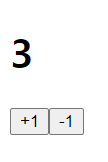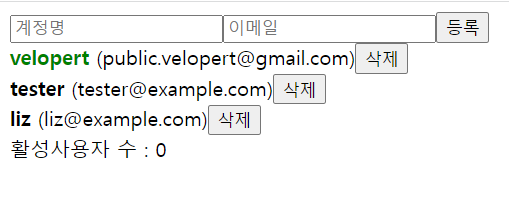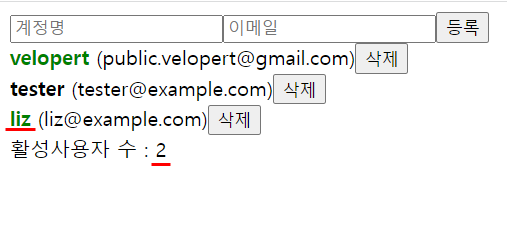#12 피곤쓰
useReducer의 활용법
이해하기
전에는 상태를 관리할 때, useState를 사용해서 새로운 상태를 설정해주었다. 그런데 이 방법 말고도 다른 새로운 방법이 있다.
바로, useReducer를 사용하는 것이다.
Hook 함수중 하나이며 컴포넌트의 상태 업데이트 로직을 컴포넌트에서 분리시킬 수 있다.
상태 업데이트 로직을 컴포넌트 바깥에 작성 할 수도 있고, 심지어 다른 파일에 작성 후 불러와서 사용 할 수도 있다.
우선, Counter.js 컴포넌트에서 useReducer를 사용해보겠다.
이전에 작성한 Counter.js
import React, { useState } from 'react';
function Counter() {
const [number, setNumber] = useState(0);
const onIncrease = () => {
setNumber(prevNumber => prevNumber + 1);
};
const onDecrease = () => {
setNumber(prevNumber => prevNumber - 1);
};
return (
<div>
<h1>{number}</h1>
<button onClick={onIncrease}>+1</button>
<button onClick={onDecrease}>-1</button>
</div>
);
}
export default Counter;useReducer 함수를 사용하기전에, reducer가 무엇인지 알아보겠다.
reducer 는 현재 상태와 액션 객체를 파라미터로 받아와서 새로운 상태를 반환해주는 함수이다.
예 )
function reducer(state, action) {
// 새로운 상태를 만드는 로직
// const nextState = ...
return nextState;
}reducer에서 반환하는 상태는 곧 컴포넌트가 지닐 새로운 상태가 된다.
여기서 action은 업데이트를 위한 정보를 가지고 있다. 주로 type 값을 지닌 객체 형태로 사용하지만, 꼭 따라야 할 규칙은 따로 없다.
action의 예 )
// 카운터에 1을 더하는 액션
{
type: 'INCREMENT'
}
// 카운터에 1을 빼는 액션
{
type: 'DECREMENT'
}
// input 값을 바꾸는 액션
{
type: 'CHANGE_INPUT',
key: 'email',
value: 'tester@react.com'
}
// 새 할 일을 등록하는 액션
{
type: 'ADD_TODO',
todo: {
id: 1,
text: 'useReducer 배우기',
done: false,
}
}action 객체의 형태는 자유이다.
이제 useReducer의 사용법에 대해 알아보겠다.
const [state, dispatch] = useReducer(reducer, initialState);useState와 비슷한 형태를 가지고 있지만 다른 역할을하고 있다.
여기서 state는 앞으로 컴포넌트에서 사용할 수 있는 상태를 가르키게 하고, dispatch는 action을 발생시키는 함수라고 이해하면 된다. dispatch 함수는 다음과 같이 사용한다.
dispatch({ type: 'INCREMENT' })그리고 useReducer 에 넣는 첫 번째 파라미터는 reducer 함수이고, 두 번째 파라미터는 초기 상태이다.
그럼 이제 Counter 컴포넌트에서 useReducer 함수를 적용해보겠다.
Counter.js
import React, { useReducer } from 'react';
function reducer(state, action) {
switch (action.type) {
case 'INCREMENT':
return state + 1;
case 'DECREMENT':
return state - 1;
default:
return state;
}
}
function Counter() {
const [number, dispatch] = useReducer(reducer, 0);
const onIncrease = () => {
dispatch({ type: 'INCREMENT' });
};
const onDecrease = () => {
dispatch({ type: 'DECREMENT' });
};
return (
<div>
<h1>{number}</h1>
<button onClick={onIncrease}>+1</button>
<button onClick={onDecrease}>-1</button>
</div>
);
}
export default Counter;잘 작동되는지 확인할려면, index.js 파일에서 App 대신 Counter를 렌더링해준다.
index.js
import React from 'react';
import ReactDOM from 'react-dom';
import App from './App';
import Counter from './Counter';
ReactDOM.render(
<React.StrictMode>
<Counter />
</React.StrictMode>,
document.getElementById('root')
);결과는...

잘 작동이되는 모습을 보고있다.
그럼 다시 index.js에서 App 컴포넌트를 렌더링해준다.
이번에는, App 컴포넌트에 있던 상태 업데이트 로직들을 useState가 아닌 useReducer를 사용하여 구현해보겠다.
우선, App에서 사용 할 초기 상태를 컴포넌트 바깥으로 분리해주고, App 내부의 로직들을 모두 제거해준다.
밑에 있는 코드를 참고하자.
App.js (수정하기 전)
import React, { useRef, useState, useMemo, useCallback } from 'react';
import UserList from './UserList';
import CreateUser from './CreateUser';
function countActiveUsers(users) {
console.log('활성 사용자 수를 세는중...');
return users.filter(user => user.active).length;
}
const initialState = {
inputs: {
username: '',
email: ''
},
users: [
{
id: 1,
username: 'velopert',
email: 'public.velopert@gmail.com',
active: true
},
{
id: 2,
username: 'tester',
email: 'tester@example.com',
active: false
},
{
id: 3,
username: 'liz',
email: 'liz@example.com',
active: false
}
]
};
function App() {
return (
<>
<CreateUser />
<UserList users={[]} />
<div>활성사용자 수 : 0</div>
</>
);
}
export default App;reducer 함수의 틀만 만들어주고, useReducer 를 컴포넌트에서 사용해겠다.
App.js (수정 후)
import React, { useRef, useReducer, useMemo, useCallback } from 'react';
import UserList from './UserList';
import CreateUser from './CreateUser';
function countActiveUsers(users) {
console.log('활성 사용자 수를 세는중...');
return users.filter(user => user.active).length;
}
const initialState = {
inputs: {
username: '',
email: ''
},
users: [
{
id: 1,
username: 'velopert',
email: 'public.velopert@gmail.com',
active: true
},
{
id: 2,
username: 'tester',
email: 'tester@example.com',
active: false
},
{
id: 3,
username: 'liz',
email: 'liz@example.com',
active: false
}
]
};
function reducer(state, action) {
return state;
}
function App() {
const [state, dispatch] = useReducer(reducer, initialState);
return (
<>
<CreateUser />
<UserList users={[]} />
<div>활성사용자 수 : 0</div>
</>
);
}
export default App;
그 다음엔, state에서 필요한 값들을 비구조화 할당 문법을 사용하여 추출하여 각 컴포넌트에게 전달하겠다.
App.js
import React, { useRef, useReducer, useMemo, useCallback } from 'react';
import UserList from './UserList';
import CreateUser from './CreateUser';
function countActiveUsers(users) {
console.log('활성 사용자 수를 세는중...');
return users.filter(user => user.active).length;
}
const initialState = {
inputs: {
username: '',
email: ''
},
users: [
{
id: 1,
username: 'velopert',
email: 'public.velopert@gmail.com',
active: true
},
{
id: 2,
username: 'tester',
email: 'tester@example.com',
active: false
},
{
id: 3,
username: 'liz',
email: 'liz@example.com',
active: false
}
]
};
function reducer(state, action) {
return state;
}
function App() {
const [state, dispatch] = useReducer(reducer, initialState);
const { users } = state;
const { username, email } = state.inputs;
return (
<>
<CreateUser username={username} email={email} />
<UserList users={users} />
<div>활성사용자 수 : 0</div>
</>
);
}
export default App;
다음으로 onChange을 구현해준다.
App.js
import React, { useRef, useReducer, useMemo, useCallback } from 'react';
import UserList from './UserList';
import CreateUser from './CreateUser';
function countActiveUsers(users) {
console.log('활성 사용자 수를 세는중...');
return users.filter(user => user.active).length;
}
const initialState = {
inputs: {
username: '',
email: ''
},
users: [
{
id: 1,
username: 'velopert',
email: 'public.velopert@gmail.com',
active: true
},
{
id: 2,
username: 'tester',
email: 'tester@example.com',
active: false
},
{
id: 3,
username: 'liz',
email: 'liz@example.com',
active: false
}
]
};
function reducer(state, action) {
switch (action.type) {
case 'CHANGE_INPUT':
return {
...state,
inputs: {
...state.inputs,
[action.name]: action.value
}
};
default:
return state;
}
}
function App() {
const [state, dispatch] = useReducer(reducer, initialState);
const { users } = state;
const { username, email } = state.inputs;
const onChange = useCallback(e => {
const { name, value } = e.target;
dispatch({
type: 'CHANGE_INPUT',
name,
value
});
}, []);
return (
<>
<CreateUser username={username} email={email} onChange={onChange} />
<UserList users={users} />
<div>활성사용자 수 : 0</div>
</>
);
}
export default App;CHANGE_INPUT 이라는 액션 객체를 사용하여 inputs 상태를 업데이트해준다.
reducer 함수에서 새로운 상태를 만들 때에는 불변성을 지켜주어야 하기 때문에 위 형태와 같이 spread 연산자를 사용주었다.
이번에는 onCreate 함수를 만들어준다.
App.js
import React, { useRef, useReducer, useMemo, useCallback } from 'react';
import UserList from './UserList';
import CreateUser from './CreateUser';
function countActiveUsers(users) {
console.log('활성 사용자 수를 세는중...');
return users.filter(user => user.active).length;
}
const initialState = {
inputs: {
username: '',
email: ''
},
users: [
{
id: 1,
username: 'velopert',
email: 'public.velopert@gmail.com',
active: true
},
{
id: 2,
username: 'tester',
email: 'tester@example.com',
active: false
},
{
id: 3,
username: 'liz',
email: 'liz@example.com',
active: false
}
]
};
function reducer(state, action) {
switch (action.type) {
case 'CHANGE_INPUT':
return {
...state,
inputs: {
...state.inputs,
[action.name]: action.value
}
};
case 'CREATE_USER':
return {
inputs: initialState.inputs,
users: state.users.concat(action.user)
};
default:
return state;
}
}
function App() {
const [state, dispatch] = useReducer(reducer, initialState);
const nextId = useRef(4);
const { users } = state;
const { username, email } = state.inputs;
const onChange = useCallback(e => {
const { name, value } = e.target;
dispatch({
type: 'CHANGE_INPUT',
name,
value
});
}, []);
const onCreate = useCallback(() => {
dispatch({
type: 'CREATE_USER',
user: {
id: nextId.current,
username,
email
}
});
nextId.current += 1;
}, [username, email]);
return (
<>
<CreateUser
username={username}
email={email}
onChange={onChange}
onCreate={onCreate}
/>
<UserList users={users} />
<div>활성사용자 수 : 0</div>
</>
);
}
export default App;이제는 onToggle과 onRemove도 구현해보겠다.
App.js
import React, { useRef, useReducer, useMemo, useCallback } from 'react';
import UserList from './UserList';
import CreateUser from './CreateUser';
function countActiveUsers(users) {
console.log('활성 사용자 수를 세는중...');
return users.filter(user => user.active).length;
}
const initialState = {
inputs: {
username: '',
email: ''
},
users: [
{
id: 1,
username: 'velopert',
email: 'public.velopert@gmail.com',
active: true
},
{
id: 2,
username: 'tester',
email: 'tester@example.com',
active: false
},
{
id: 3,
username: 'liz',
email: 'liz@example.com',
active: false
}
]
};
function reducer(state, action) {
switch (action.type) {
case 'CHANGE_INPUT':
return {
...state,
inputs: {
...state.inputs,
[action.name]: action.value
}
};
case 'CREATE_USER':
return {
inputs: initialState.inputs,
users: state.users.concat(action.user)
};
case 'TOGGLE_USER':
return {
...state,
users: state.users.map(user =>
user.id === action.id ? { ...user, active: !user.active } : user
)
};
case 'REMOVE_USER':
return {
...state,
users: state.users.filter(user => user.id !== action.id)
};
default:
return state;
}
}
function App() {
const [state, dispatch] = useReducer(reducer, initialState);
const nextId = useRef(4);
const { users } = state;
const { username, email } = state.inputs;
const onChange = useCallback(e => {
const { name, value } = e.target;
dispatch({
type: 'CHANGE_INPUT',
name,
value
});
}, []);
const onCreate = useCallback(() => {
dispatch({
type: 'CREATE_USER',
user: {
id: nextId.current,
username,
email
}
});
nextId.current += 1;
}, [username, email]);
const onToggle = useCallback(id => {
dispatch({
type: 'TOGGLE_USER',
id
});
}, []);
const onRemove = useCallback(id => {
dispatch({
type: 'REMOVE_USER',
id
});
}, []);
return (
<>
<CreateUser
username={username}
email={email}
onChange={onChange}
onCreate={onCreate}
/>
<UserList users={users} onToggle={onToggle} onRemove={onRemove} />
<div>활성사용자 수 : 0</div>
</>
);
}
export default App;마지막으로 활성사용자 수도 구현해보겠다.
App.js
import React, { useRef, useReducer, useMemo, useCallback } from 'react';
import UserList from './UserList';
import CreateUser from './CreateUser';
function countActiveUsers(users) {
console.log('활성 사용자 수를 세는중...');
return users.filter(user => user.active).length;
}
const initialState = {
inputs: {
username: '',
email: ''
},
users: [
{
id: 1,
username: 'velopert',
email: 'public.velopert@gmail.com',
active: true
},
{
id: 2,
username: 'tester',
email: 'tester@example.com',
active: false
},
{
id: 3,
username: 'liz',
email: 'liz@example.com',
active: false
}
]
};
function reducer(state, action) {
switch (action.type) {
case 'CHANGE_INPUT':
return {
...state,
inputs: {
...state.inputs,
[action.name]: action.value
}
};
case 'CREATE_USER':
return {
inputs: initialState.inputs,
users: state.users.concat(action.user)
};
case 'TOGGLE_USER':
return {
...state,
users: state.users.map(user =>
user.id === action.id ? { ...user, active: !user.active } : user
)
};
case 'REMOVE_USER':
return {
...state,
users: state.users.filter(user => user.id !== action.id)
};
default:
return state;
}
}
function App() {
const [state, dispatch] = useReducer(reducer, initialState);
const nextId = useRef(4);
const { users } = state;
const { username, email } = state.inputs;
const onChange = useCallback(e => {
const { name, value } = e.target;
dispatch({
type: 'CHANGE_INPUT',
name,
value
});
}, []);
const onCreate = useCallback(() => {
dispatch({
type: 'CREATE_USER',
user: {
id: nextId.current,
username,
email
}
});
nextId.current += 1;
}, [username, email]);
const onToggle = useCallback(id => {
dispatch({
type: 'TOGGLE_USER',
id
});
}, []);
const onRemove = useCallback(id => {
dispatch({
type: 'REMOVE_USER',
id
});
}, []);
const count = useMemo(() => countActiveUsers(users), [users]);
return (
<>
<CreateUser
username={username}
email={email}
onChange={onChange}
onCreate={onCreate}
/>
<UserList users={users} onToggle={onToggle} onRemove={onRemove} />
<div>활성사용자 수 : {count}</div>
</>
);
}
export default App;그리고 모든 기능들이 잘 작동하는지 확인해준다.

liz 라는 username을 클릭하니 활성사용자 수가 2로 바뀌었다.
useReducer를 통해서 모두 구현이 완료되었다.
useReducer vs useState
어떠할 때 useReducer 를 쓰고 어떨 때 useState 를 써야 할까?
정해진 답은 없다.
예를 들어서 컴포넌트에서 관리하는 값이 딱 하나고, 그 값이 단순한 숫자, 문자열 또는 boolean 값이라면 확실히 useState로 관리하는게 편리하다.
const [value, setValue] = useState(true);하지만 만약에 컴포넌트에서 관리하는 값이 여러개이고 상태의 구조가 복잡해진다면, useReducer로 관리하는 것이 편해진다.
앞으로의 결정들은 둘 다 자주 사용해보고 맘에드는 방식을 택하면되겠다.
참고 : 벨로퍼트와 함께하는 모던 리액트
느낀점 :
- 오늘은 useState와 비슷한 구조를 갖고있는 useReducer에 대해 알아보는 시간을 가졌다.
- 확실히 둘 다 이해할려면 더 많이 코드를 찾아봐서 분석하고 내 것으로 만드는 답 밖에 없다.